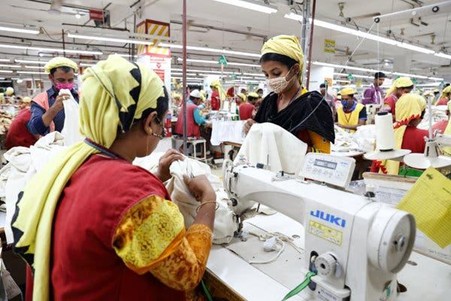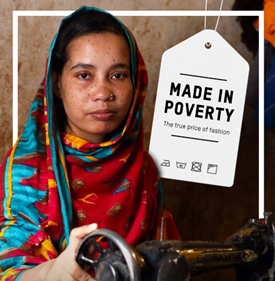Gender inequality beneath the seams: an overview of the effects of the RMG industry on Bangladeshi women
In a growingly consumer-driven, fast-paced capitalist society, fast fashion trends can not seem to stop rising: consumer’s desire for cheap and trendy clothing in a context where a piece of clothing can be outdated in just a few weeks. The fast fashion industry, also referred to as the ready-made garment (RMG) sector, is particularly characterised by extremely rapid production cycles that bring new trends to market, which inevitably leads to the mass consumption of specific clothing items over short periods of time (that at the same time is emphasised by shorter-lived garment use). This industry generates over 92 million tonnes of waste, consumes 79 trillion litres of water annually (Magwegwe & Shaik, 2024), and employs approximately 75 million factory workers worldwide, particularly across South-Asian countries such as India, China, Vietnam, Indonesia, and Bangladesh. Of these 75 million workers worldwide, only less than 2% earn a living wage (Earth Day Org, 2024), and this exploitation disproportionately impacts women. So, when it comes to fast and cheap fashion, the clothes we wear come at the cost of women’s wellbeing, dignity, and life.
The introduction of the concept of intersectionality, which arises in the basis of the workplace, is essential to understanding the multi-layer reality of climate change intersecting with gender. These layers of privilege—race, disability, gender, nationality, or sexuality—are added accounts that can change your reality and position in the world. The more layers of discrimination, the more possible you are to live in inequality and violence. Authors Hewamanne and South describe the RMG as “pooricide”, the genocide of the poor. This is particularly important because it is incredibly relevant to gender studies: as we mention throughout the website, women are the “world’s poor”. (Hewamanne & South, 2023). This analysis aims to scrutinise the double burden Bangladeshi women face as workers in the garment industry; and as women in society.

Figure 1. Monir, F. (2020) Hundreds of thousands of Bangladeshi garment workers are facing unemployment. Available at: https://www.nytimes.com/2020/03/31/fashion/coronavirus-bangladesh.html
The intersection between gender and the effects (or in the case of fast fashion, the causes) of climate change may not always be obvious: being part of the so-called second sex may seem as more of a hidden exacerbation of already existing poor conditions than an issue to be studied in depth. Truth is, as we have mentioned in previous articles, to be a woman in any situation of pressure and precarious situations is to be doubly vulnerable: as a citizen and as a woman. “Climate Change does not create inequalities; it magnifies them. Women, particularly in developing countries, are caught in a cycle where their socio-economic marginalization is both a cause and consequence of their vulnerability to environmental crises” (Alston, 2015). Particularly in the ready-made garment (RMG) sector, the adverse effects of climate change and global production systems on wellbeing are deadly: just to get an idea of what the industry does for people, an Oxfam Australia report reveals that 91% of Bangladeshi garment workers struggle to afford enough food for themselves and their families and 25% of them face some form of abuse (Oxfam Australia, 2021). Yet, only 1% of brands disclose how many of their garment workers earn a living wage. Apart from the exploitation in unsafe and non-regulated working conditions, inequitable low wages, and exposure to worker violence, women are more prone to suffering sexual and/or gender violence, making the workplace a place of danger to which no human should be subject. And not only the inherent conditions of the RMG industry make women vulnerable, but also the effects of it. The pollution and resource depletion that the producing countries are experiencing only because the financiers and consumers are capitally interested in getting the cheapest possible low-cost production to maximize profit are causing frequent flooding and rising sea levels in Bangladesh and are worsening the competition for resources, access to water and food, and exacerbating pre-existing gender disparities and gender-based violence.

Figure 2: Oxfam Australia (2021) Made in poverty: The true price of fashion.
For women, fleeing the unsafe conditions they have been practically forced to live in in order to survive is often not even an option. They face exploitative wages (often resulting in the need to go into debt to cover basic living expenses), unsafe working conditions, and limited opportunities for upward mobility (Karim, 2014), along with a structural constraint over the possibility of breaking generational inequalities. If a working mother of two can barely afford to feed herself and her children, she is not able to provide them with an education, and they will most probably need to become RMG workers to support the family.
In simple terms, the fast-fashion industry is a double-edged sword: it worsens climate change and consequently the effects of it over gender inequality; and it worsens the life conditions of those that are part of its production, therefore making it even more difficult for them to escape the cycle of poverty and violence.
Is change attainable? As proposed by authors Vijeyarasa and Liu, a possible gender-just framework for the fast fashion industry to better adjust to women’s needs and rights would be to align it with the Sustainable Development Goals (SDGs) (Vijeyarasa & Liu, 2022), advocating for the integration of both gender equity, just working conditions, and sustainability into corporate and policy frameworks to adapt the industry to a fair industry. Nonetheless, this apparent solution does not tackle the root causes of gender inequality such as women being more prone to suffer violence in a context of poverty (and in other contexts) and fails to analyze practically labour rights and wages systemically: the Bangladesh government, for instance, heavily relies on the RMG sector for foreign direct investment, export earnings, and employment, prioritising growth over worker’s rights (Horton, Street, & O’Brien, 2022). Though there is no clear solution for the fast fashion and climate change effects on gender inequality, the first step could be to be environmentally and socially conscious. Ethical considerations often take a backseat to affordability and convenience (Horton, Street, & O’Brien, 2022), but raising awareness and talking about the unfairness of the situation is the first step towards the road of sustainability and improvement.
Bangladeshi women will continue to suffer when the intersection of their burdens results in grievances in their lives. It is only through a collective sense of injustice, that proactive steps can be taken to mitigate these afflictions. Through small individual steps, just as consuming wisely from Shein, Zara, Temu or Primark—or overall avoiding them—ensures we make conscious decisions, ones that bear in mind the millions of women behind the garment industry selling their lives, safety, and family for 55 cents an hour.
List of references
Alston, M. (2015) Women and climate change in Bangladesh. Routledge.
EarthDay.org (2024) ‘Beneath the seams: The human toll of fast fashion’. Available at: https://www.earthday.org/beneath-the-seams-the-human-toll-of-fast-fashion/.
Ahmed, F.E. (2004) ‘The rise of the Bangladesh garment industry: Globalization, women workers, and voice’, NWSA Journal, 16(2), pp. 34–45. Available at: http://www.jstor.org/stable/4317051.
Karim, L. (2014) ‘Analyzing women’s empowerment: Microfinance and garment labor in Bangladesh’, The Fletcher Forum of World Affairs, 38(2), pp. 153–166. Available at: http://www.jstor.org/stable/45289749.
Magwegwe, F.M. and Shaik, A. (2024) ‘Theory of planned behavior and fast fashion purchasing: An analysis of interaction effects’, Current Psychology, 43, pp. 28868–28885. doi: https://doi.org/10.1007/s12144-024-06465-9.
Oxfam Australia (2021) Made in poverty: The true price of fashion. Available at: https://www.oxfam.org.au/wp-content/uploads/2021/11/Made-in-Poverty-the-True-Price-of-Fashion-Oxfam-Australia.pdf.
Vijeyarasa, R. and Liu, M. (2022) ‘Fast fashion for 2030: Using the pattern of the sustainable development goals (SDGs) to cut a more gender-just fashion sector’, Business and Human Rights Journal, 7(1), pp. 45–66.